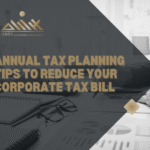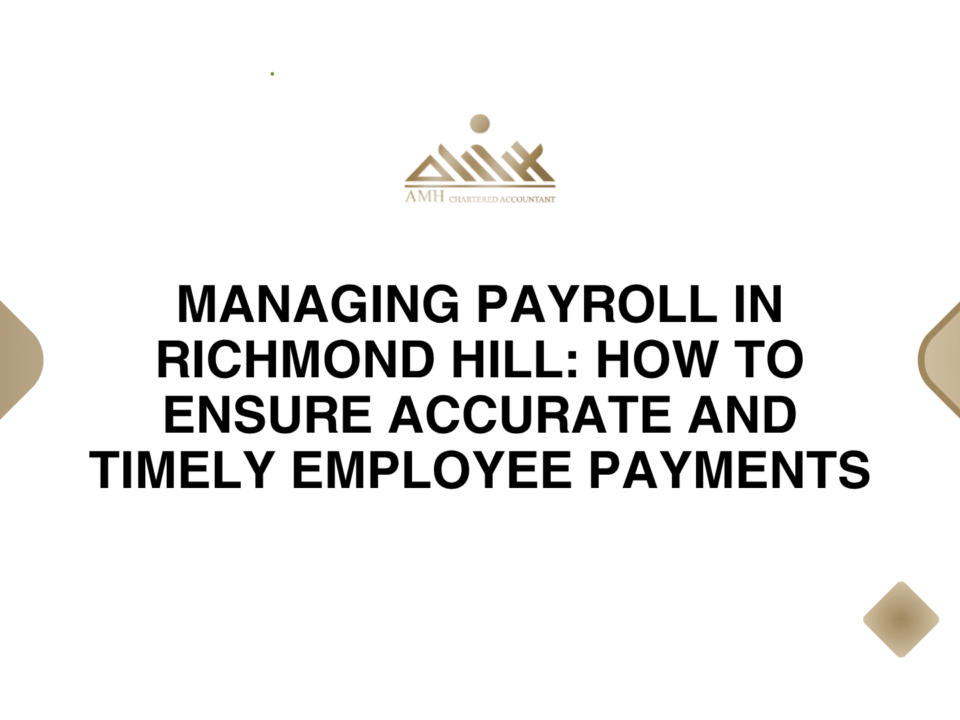
Managing Corporate Debt: Smart Strategies to Maintain Financial Health
August 10, 2025
Annual Tax Planning Tips to Reduce Your Corporate Tax Bill
August 20, 2025What Should Be Included in Your Year-End Financial Statements?
Year-end financial statements are essential for assessing the financial performance of your business and ensuring tax compliance. These statements provide a clear view of your company’s financial health and help you make informed decisions for the future. At AMH Chartered Professional Accountant, we provide businesses in Toronto, Milton, Oakville, Hamilton, Kitchener, and Waterloo with expert assistance in preparing accurate and comprehensive year-end financial statements.
Introduction: The Importance of Year-End Financial Statements
At the end of each fiscal year, businesses are required to prepare financial statements that summarize the financial activities of the company for the year. These documents are critical for several reasons, including:
Tax Filing: Year-end financial statements are essential for preparing and filing accurate tax returns with the Canada Revenue Agency (CRA).
Financial Analysis: They provide valuable insights into your company’s profitability, cash flow, and financial position.
Investor and Stakeholder Communication: Investors, stakeholders, and lenders rely on accurate financial statements to assess the company’s financial health and make informed decisions.
Business Planning: Accurate year-end statements are crucial for setting realistic financial goals for the upcoming year and ensuring long-term business success.
In this article, we will explain the key components of year-end financial statements, common mistakes to avoid, and how you can ensure that your year-end financials are prepared accurately.
What Are Year-End Financial Statements?
Year-end financial statements summarize a company’s financial performance over the course of the fiscal year. They provide detailed information on revenue, expenses, assets, liabilities, and overall financial performance. These statements are critical for external parties like investors, lenders, and tax authorities, as they help assess the company’s financial health and viability.
The core year-end financial statements include:
Balance Sheet: A snapshot of the company’s financial position at a specific point in time.
Income Statement (Profit and Loss Statement): A report that tracks the company’s profitability over a specific period.
Cash Flow Statement: A statement that outlines the movement of cash in and out of the business.
Statement of Retained Earnings: A report that shows the changes in the company’s retained earnings over the year.
Each of these statements provides valuable insights that can help your business grow, remain compliant, and attract investors.
Key Components of Year-End Financial Statements
Year-end financial statements are made up of several key documents, each with a specific purpose. Here’s a breakdown of what each statement includes and how they work together to give you a clear view of your company’s financial health.
1. Balance Sheet: Assessing Your Company’s Financial Position
The balance sheet provides a snapshot of your business’s financial position at the end of the year, showing assets, liabilities, and equity. The balance sheet is divided into two sections:
Assets: These are the resources owned by your business, such as cash, inventory, equipment, and real estate. Assets are further categorized into current (short-term) and non-current (long-term) assets.
Liabilities: These are the debts your business owes to external parties, such as loans, accounts payable, and other financial obligations. Liabilities are also divided into current (due within one year) and non-current (long-term).
Equity: This represents the ownership interest in the business, including the invested capital and retained earnings.
The equation for the balance sheet is:
Assets = Liabilities + Equity
This fundamental equation ensures that your balance sheet is always balanced and provides insight into the company’s solvency and ability to meet its financial obligations.
2. Income Statement (Profit and Loss Statement): Tracking Profitability
The income statement, also known as the profit and loss (P&L) statement, summarizes your business’s revenues and expenses over the fiscal year. It helps you track profitability by showing whether your business has generated a profit or incurred a loss.
The key sections of the income statement are:
Revenue: The total income your business has generated from sales of goods or services.
Cost of Goods Sold (COGS): The direct costs associated with producing the goods or services sold.
Gross Profit: Revenue minus COGS. This shows how much money the business has earned after covering direct production costs.
Operating Expenses: Indirect costs related to running the business, such as marketing, salaries, rent, and utilities.
Operating Income: Gross profit minus operating expenses. This shows the profit generated from core business operations.
Net Income: The final bottom line, calculated by subtracting interest, taxes, and other non-operating expenses from operating income.
The income statement provides insights into your company’s ability to generate profit and manage expenses, helping investors and stakeholders assess financial health.
3. Cash Flow Statement: Analyzing Cash Movement
The cash flow statement tracks the inflow and outflow of cash within your business. Unlike the income statement, which includes non-cash items like depreciation, the cash flow statement focuses solely on actual cash transactions. It is divided into three sections:
Operating Activities: Cash generated or used by core business activities, such as sales, purchases, and employee salaries.
Investing Activities: Cash flows related to buying or selling long-term assets, such as equipment, property, or investments.
Financing Activities: Cash flows associated with borrowing, repaying debt, and issuing or buying back shares.
By analyzing the cash flow statement, you can determine how effectively your business is managing its cash, ensuring that you have enough liquidity to meet obligations and invest in growth.
4. Statement of Retained Earnings: Understanding Earnings Allocation
The statement of retained earnings shows how your business’s earnings are allocated between dividends and reinvestment in the company. It outlines changes in retained earnings over the year, including:
Net Income: The profit generated, which is added to retained earnings.
Dividends: Any earnings paid out to shareholders.
Changes in Retained Earnings: The increase or decrease in retained earnings, reflecting the company’s decision to reinvest or distribute profits.
The statement of retained earnings is a valuable tool for understanding how the company is utilizing its profits to fund growth or distribute value to shareholders.
Additional Financial Statements and Notes
In addition to the core financial statements, year-end reporting may include additional documents, such as:
Statement of Comprehensive Income: This includes gains and losses not reflected in the income statement, such as foreign exchange fluctuations or investment revaluations.
Notes to the Financial Statements: These notes provide additional context and detail, explaining accounting policies, risks, and any significant events during the year.
Including these additional documents ensures that your financial statements are complete and comply with accounting standards.
Adjusting Entries for Year-End Reporting
At the end of the year, businesses may need to make adjusting entries to account for transactions that haven’t been recorded or that require correction. These entries include:
Accruals: Adjusting for expenses that have been incurred but not yet paid.
Deferrals: Adjusting for payments received in advance or expenses that have been prepaid.
Depreciation: Allocating the cost of tangible assets over their useful life.
Making these adjustments ensures that your financial statements are accurate and reflect the true financial position of the business.
How to Ensure Accuracy in Your Year-End Financial Statements
Accurate year-end financial statements are essential for making informed decisions and ensuring tax compliance. Here are some tips for ensuring accuracy:
Reconcile Accounts: Ensure that all accounts, including bank accounts, accounts receivable, and accounts payable, are properly reconciled.
Review Documentation: Double-check all supporting documents, such as invoices, receipts, and contracts, to ensure accuracy.
Consult a Professional: Engage with a professional accountant, like AMH Chartered Professional Accountant, to review your financial statements for errors and ensure they meet regulatory standards.
The Role of Accounting Software in Year-End Financial Reporting
Using accounting software like QuickBooks, Xero, or Sage can streamline the process of preparing year-end financial statements. These tools help automate the creation of financial reports, track transactions in real-time, and ensure that your statements are accurate and compliant with accounting standards.
How AMH Chartered Professional Accountant Can Help
At AMH Chartered Professional Accountant, we provide expert assistance in preparing year-end financial statements for businesses of all sizes. Our services include:
Financial Statement Preparation: We ensure that your year-end financial statements are accurate and compliant with all relevant regulations.
Tax Planning and Reporting: We help you optimize your tax situation and ensure accurate tax filings.
Business Consulting: Our team can offer advice on using financial statements for business growth, forecasting, and investment.
Common Mistakes to Avoid in Year-End Financial Statements
Neglecting Adjusting Entries: Failing to make necessary adjustments can lead to inaccurate financial statements.
Underestimating Depreciation: Ensure that depreciation is properly accounted for on assets.
Inconsistent Reporting: Keep accounting practices consistent year over year to ensure comparability.
Key Tax Considerations for Year-End Financial Reporting
Year-end financial reporting is closely tied to tax planning. Make sure to:
Review Tax Deductions: Ensure that all deductible expenses are included in the financial statements.
Plan for Tax Liabilities: Estimate your tax obligations and make provisions to cover them.
Optimize Tax Strategies: Consider strategies like deferring income or accelerating expenses to reduce taxable income.
Future Trends in Year-End Reporting and Financial Statements
As technology advances, we can expect greater automation in year-end reporting, with AI tools that can predict financial outcomes and identify trends. Cloud-based accounting will continue to grow, providing real-time updates and more accurate financial reporting.
Conclusion: Ensuring Accurate Year-End Financial Statements
Year-end financial statements are a key component of your business’s financial reporting, and preparing them accurately is essential for tax compliance, business planning, and attracting investors. By following best practices, using professional tools, and seeking expert advice, you can ensure that your year-end financials are precise, comprehensive, and ready for the year ahead.
At AMH Chartered Professional Accountant, we are here to help you prepare accurate and reliable year-end financial statements, ensuring your business’s financial health and success.
FAQs
What financial statements are needed for year-end reporting?
The key financial statements include the Balance Sheet, Income Statement, Cash Flow Statement, and Statement of Retained Earnings.
How can I ensure my year-end financials are accurate?
Reconcile your accounts, double-check documentation, and consider consulting a professional accountant to review your statements.
Can AMH help me with year-end financial reporting?
Yes, AMH Chartered Professional Accountant specializes in preparing year-end financial statements and providing tax planning services.
What is the role of depreciation in year-end financial statements?
Depreciation helps allocate the cost of tangible assets over their useful life, reducing taxable income and reflecting asset wear and tear.
Do I need to adjust my accounts before year-end?
Yes, you may need to make adjusting entries for accruals, deferrals, and depreciation to ensure your financial statements are accurate.




